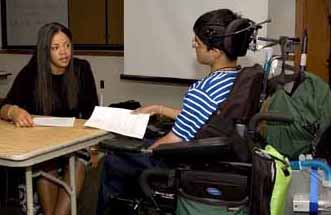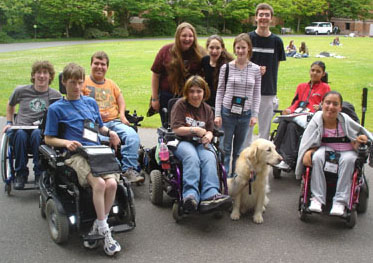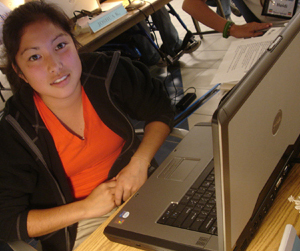Self-Determination

The challenge is to effectively provide an education for students with a wide array of learning styles and accommodation requirements. The opportunity is to create a society that allows everyone to participate and contribute. With growing numbers of students with disabilities joining general education classes and with legal and ethical directives to provide an appropriate and integrated education for all citizens, it is important for educators to know how to fully include students with disabilities in classroom activities.
Listen to the Experts
Participants in the DO-IT Scholars program develop problem-solving skills while still in high school. Following is an example of an activity that helped them develop self-determination skills during a Summer Study session at the University of Washington.
After a long day of activities on a hot summer afternoon in the DO-IT Summer Study program, DO-IT Scholars came together to discuss learning strategies. All of the participants in this group were dealing with learning issues as a result of their disabilities. Disabilities represented included specific learning disabilities, attention-deficit disorder (ADD), attention-deficit/hyperactivity disorder (ADHD), Tourette's syndrome, and head injury. First, Scholars shared ways in which their disabilities have impacted their ability to learn. Impacts Scholars mentioned included that they:
- are slow at taking tests
- read slowly
- have messy handwriting
- have difficulty expressing thoughts in writing
- feel frustrated
- are unorganized
- are easily distracted
- feel stupid
- feel overwhelmed
They all agreed that although their disabilities impact their ability to learn in a typical classroom, they have the ability to learn. They listed strategies that help them succeed in academics in spite of their learning challenges. These strategies allow them to work to their full potential and demonstrate their abilities. Solutions Scholars mentioned during this brainstorming session included:
- asking the instructor to suggest strategies for succeeding in the class
- working in an environment with a minimum of distractions
- studying during times of the day when they have the most energy
- arranging for extended time on tests
- taking tests orally
- outlining ideas and information while reading or reviewing notes
- using different colored pens to highlight key points
- using colored transparent screens to cover pages or computer screens while reading
- using a computer (especially word processors, spelling checkers, and grammar checkers)
- using a large-print font on the computer
- utilizing study groups
- taking breaks from reading to keep their minds fresh
- recording lectures
- reading aloud or having someone else read to them
- getting notes from the teacher or another person in the class
- using a class planner
The participants in the group discovered that they have some shared solutions and some unique ones. They found that a solution that makes a difference for one person might not help another. They also learned that they need to take an active role in figuring out what works for them and determining which strategies they can implement and which accommodations need to be requested from a teacher. Although others can make suggestions, it's important for students with disabilities to try out accommodations and decide whether or not they are effective. They need to become experts in their disabilities and the unique accommodations that will work for them. Additionally, it is critical that educators work with them to further develop accommodation and self-advocacy skills.
Teaching Students to Take Charge
We often hear about the problems young people with disabilities face—physical obstacles, social rejection, academic failure, and medical crises. Yet some people do overcome significant challenges and lead successful lives. What does success mean to them, and how do they achieve it? What internal characteristics do these individuals possess, and what external factors have been present in their lives? What advice do they have to help young people build personal strengths to overcome the challenges they no doubt will face?
Read the publication and view the video Taking Charge: Stories of Success and Self-Determination for insights from successful young people and adults with disabilities. These insights can help you understand how people can learn to lead self-determined lives.
What is self-determination? There are many definitions to choose from. The following definition is concise and incorporates a number of common themes found in other definitions.
Self-determination is a combination of skills, knowledge, and beliefs that enable a person to engage in goal-directed, self-regulated, autonomous behavior. An understanding of one's strengths and limitations together with a belief in oneself as capable and effective are essential to self-determination. When acting on the basis of these skills and attitudes, individuals have greater ability to take control of their lives and assume the role of successful adults (Field et al., 1998, p. 115).
Gaining control over your life involves learning and then successfully applying a number of self-determination skills, such as goal setting, understanding your abilities and disabilities, problem solving, and self-advocacy. The personal process of learning, using, and self-evaluating these skills in a variety of settings is at the heart of self- determination.
The content in the Taking Charge: Stories of Success and Self-Determination publication and video is organized around the following advice synthesized from hundreds of responses by successful young people and adults with disabilities:
- Define success for yourself.
- Set personal, academic, and career goals.
- Keep your expectations high.
- Understand your abilities and disabilities.
- Play to your strengths.
- Develop strategies to meet your goals.
- Use technology as an empowering tool.
- Persevere.
- Be flexible.
- Work hard.
- Develop a support network. Look to family, friends, and teachers.
Young people with disabilities can find the experiences of others useful as they set their course toward successful, self-determined lives.

Mentoring
Most of us can think of people in our lives, more experienced than ourselves, who have supplied information, offered advice, presented a challenge, initiated friendship, or simply expressed an interest in our development as a person. Without their intervention, we may have remained on the same path, perhaps continuing a horizontal progress through our academic, career, or personal lives.
Adult mentors can help students with disabilities achieve success in STEM. Mentors provide direction and encouragement. They instill values and promote achievement. They can also help students develop self-advocacy and leadership skills. However, constraints imposed by time, distance, and disability make such relationships difficult to initiate.
View the video and read the publication Opening Doors: Mentoring on the Internet to hear firsthand about the value of mentoring and about how using the Internet for communication can overcome challenges imposed by time, distance, and disability. View the video and read the publication DO-IT Pals to learn about a DO-IT program for online peer and mentor support available to any teen with a disability.
DO-IT has conducted a research study on the nature and value of electronic mentoring (Burgstahler & Cronheim, 2001). More than 12,000 email messages were coded and analyzed, surveys were distributed, and focus groups were conducted. Results of the study suggest that computer-mediated communication can be used to initiate and sustain both peer-peer and mentor-protégé relationships. On the Internet, young people can receive support from peers and adults otherwise difficult to reach, as well as connect to a rich collection of science and math resources. Participants experience benefits over other types of communication, including the ability to communicate over great distances quickly, easily, conveniently, and inexpensively; the elimination of the barriers of distance and schedule; the ability to communicate with more than one person at one time; and the opportunity to meet people from all over the world. Students with disabilities also report the added value that people treat them equally because they are not immediately aware of their disabilities.
To help teenagers with disabilities meet other students with disabilities and develop mentoring relationships with adults who have disabilities, encourage them to join the DO-IT electronic community. They can check into the DO-IT Pals program, in which teens with disabilities communicate year-round with each other and with mentors via the Internet. For information about these and other programs, select Programs at https://www.washington.edu/doit/, or send email to doit@uw.edu.
For more information about self-determination and related topics, consult the AccessSTEM website.

Preparing Students for College and Careers
Because of their disabilities, some adults do not share many of the experiences that are common among their nondisabled peers, including attending college and attaining a career. Increased awareness of the rights and contributions of individuals with disabilities has resulted in a growing concern about expanding their postsecondary options.
Transitions from high school to college and careers include three phases:
- preparing for college, including preparations that occur in high school
- staying in college, which requires numerous self-management skills
- preparing for moving beyond college and to a career
Read the publication and view the video College: You Can DO-IT! for ideas regarding how you can help prepare students for college. For guidance on preparing students for successful transitions from two-year to four-year postsecondary institutions, view the video and read the publication Moving On: The Two-Four Step. In addition, the videos and handouts Learn and Earn: Tips for Teens and Learn and Earn: Supporting Teens (relevant to precollege programs), as well as It's Your Career: Work-Based Learning Opportunities for College Students with Disabilities and Access to the Future: Preparing College Students with Disabilities for Careers (relevant to college programs) provide guidelines for helping students with disabilities prepare for careers and making career development services accessible to students with disabilities. Information about fully including students with disabilities in work-based learning programs can be found in the video and publications titled Finding Gold: Hiring the Best and the Brightest.
Tips: The Importance of Self-Determination
When instructing preservice or inservice teachers, emphasize the importance of promoting self-determination for all students but particularly for students with disabilities. Teachers can help students prepare for postsecondary studies and adult life by:
- involving students in the accommodation process, thereby helping them become experts on their disabilities, good problem solvers, and self-advocates
- keeping expectations high for students with disabilities
- talking to students about college and career goals and steps for reaching them
- encouraging students to actively participate in academic and career preparation activities and use assistive technology as an empowering tool
Communication Hints
Treat people with disabilities with the same respect and consideration with which you treat others. There are no strict rules when it comes to relating to people with disabilities. However, here are some helpful hints.
General
- Ask a person with a disability if they need help before providing assistance.
- Talk directly to the person with a disability, not through the person's companion or interpreter.
- Refer to a person's disability only if it is relevant to the conversation. If so, mention the person first and then the disability. "A man who is blind" is better than "a blind man" because it puts the person first.
- Avoid negative descriptions of a person's disability. For example, "a person who uses a wheelchair" is more appropriate than "a person confined to a wheelchair." A wheelchair is not confining—it's liberating!
- Do not interact with a person's guide dog or service dog unless you have received permission to do so.
Blind or Low Vision
- Be descriptive. Say, "The computer is about three feet to your left," rather than "The computer is over there."
- Speak all of the content presented with overhead projections and other visuals.
- When guiding people with visual impairments, offer them your arm rather than grabbing or pushing them.
Learning Disabilities
- Offer directions or instructions both orally and in writing. If asked, read instructions to individuals who have specific learning disabilities.
Mobility Impairments
- Sit or otherwise position yourself at the approximate height of people sitting in wheelchairs when you interact.
Speech Impairments
- Listen carefully. Repeat what you think you understand and then ask the person with a speech impairment to clarify or repeat the portion that you did not understand.
Deaf or Hard of Hearing
- Face people with hearing impairments so they can see your lips. Avoid talking while chewing gum or eating.
- Speak clearly at a normal volume. Speak louder only if requested.
- Use paper and pencil if the person who is deaf does not read lips or if more accurate communication is needed.
- In groups raise hands to be recognized so the person who is deaf knows who is speaking. Repeat questions from audience members.
- When using an interpreter, speak directly to the person who is deaf; when an interpreter voices what a person who is deaf signs, look at the person who is deaf, not the interpreter.
Psychiatric Impairments
- Provide information in clear, calm, respectful tones.
- Allow opportunities for addressing specific questions.